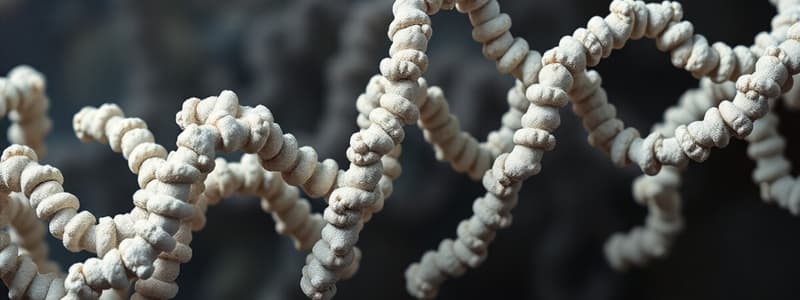Podcast
Questions and Answers
What are the two predominant types of secondary structures found in proteins?
What are the two predominant types of secondary structures found in proteins?
Alpha-helices and beta-strands are the two predominant types of secondary structures in proteins.
How many angles per residue describe a protein's backbone conformation?
How many angles per residue describe a protein's backbone conformation?
A protein's backbone conformation can be described by three angles per residue.
Define the dihedral angle in the context of protein structure.
Define the dihedral angle in the context of protein structure.
The dihedral angle is the angle formed between the A-B bond and the C-D bond when viewed down the B-C bond.
What effect do Van der Waals clashes have on single-bond dihedral angle preferences?
What effect do Van der Waals clashes have on single-bond dihedral angle preferences?
What connects each alpha-carbon (Ca) to the next in a protein backbone?
What connects each alpha-carbon (Ca) to the next in a protein backbone?
Why is it important to understand the angles that dictate protein conformation?
Why is it important to understand the angles that dictate protein conformation?
Explain how the arrangement of residues influences protein secondary structure.
Explain how the arrangement of residues influences protein secondary structure.
What are the names of the three angles that describe a protein's backbone conformation?
What are the names of the three angles that describe a protein's backbone conformation?
Explain how the presence of three angles per residue affects a protein's conformation.
Explain how the presence of three angles per residue affects a protein's conformation.
Why are the dihedral angles phi (F) and psi (Y) particularly important in protein structure?
Why are the dihedral angles phi (F) and psi (Y) particularly important in protein structure?
What role does the conformation of the protein backbone play in its functionality?
What role does the conformation of the protein backbone play in its functionality?
How does the length of a bond affect VDW interactions?
How does the length of a bond affect VDW interactions?
What is measured by the Omega angle in protein structure?
What is measured by the Omega angle in protein structure?
How is the Omega angle measured?
How is the Omega angle measured?
Why is the understanding of the Omega angle significant in protein conformation?
Why is the understanding of the Omega angle significant in protein conformation?
What constitutes the Omega angle in relation to protein residues?
What constitutes the Omega angle in relation to protein residues?
Which atoms define the Omega angle in a peptide bond?
Which atoms define the Omega angle in a peptide bond?
Study Notes
Secondary Structure of Proteins
- Secondary structure pertains to the spatial arrangement of amino acid residues that are close in sequence within a protein chain.
- Common forms of secondary structures include alpha-helices and beta-strands, which dominate protein architecture.
Protein Backbone Conformation
- Backbone conformation is influenced by the bonds connecting one alpha carbon (Ca) to the next.
- Each Ca in a protein is connected by three types of bonds, resulting in three angles per amino acid residue: omega (W), phi (F), and psi (Y).
Dihedral Angles
- Dihedral angles describe the orientation of bonds between four connected atoms (A-B-C-D).
- The dihedral angle measures the angle between the A-B bond and the C-D bond, viewed down the B-C bond axis and measured clockwise.
Van der Waals Clashes
- The preferences for single-bond dihedral angles in proteins are dictated by the avoidance of Van der Waals clashes, which occur when atoms are too close to each other.
Protein Backbone Conformation
- The conformation of a protein backbone is determined by the bonds linking each amino acid residue.
- Each alpha carbon (Cα) in a protein is connected to the next Cα by three specific bonds.
- The conformation can be described using three angles associated with these bonds for each residue.
- The three key angles are:
- Omega (Ω): The dihedral angle around the C-N bond between successive amino acids.
- Phi (φ): The dihedral angle around the Cα-C bond, influencing the structure's overall shape.
- Psi (ψ): The dihedral angle around the Cα-C bond, also critical for protein folding.
- These angles play a significant role in determining the protein’s secondary and tertiary structure.
Protein Secondary Structure
- Secondary structure refers to local arrangements of residues within a protein, primarily forming alpha-helices or beta-strands.
- The predominant conformations are influenced by specific interactions and the protein backbone structure.
Protein Backbone Conformation
- The conformation is dictated by the bonds connecting residues, specifically the three types of angles: omega (W), phi (F), and psi (Y).
- Each angle describes the rotation around bonds connecting carbon alpha (Ca) atoms.
Dihedral Angles
- Defined based on four connected atoms (A-B-C-D), indicating the angle between the A-B and C-D bonds, measured looking down the B-C bond.
- Clockwise measurements provide a standard method for defining these angles.
Van der Waals Clashes
- Favorable dihedral angles are determined by minimizing steric hindrance or clashes between atoms, particularly in short single bonds.
- The arrangement of atoms affects stability and contributes to the overall structure of the protein.
Secondary Structure of Proteins
- Secondary structure involves the spatial arrangement of amino acid residues close in sequence.
- Common secondary structures include alpha-helices and beta-strands.
- Dominance of specific arrangements over others is influenced by protein backbone conformation.
Protein Backbone Conformation
- The protein backbone consists of bonds joining each alpha carbon (Ca) to the next.
- Each residue contributes three dihedral angles: omega (W), phi (F), and psi (Y).
Dihedral Angles
- Dihedral angles describe the rotation of bonds around a backbone.
- The dihedral angle is the angle formed between the bonds of non-adjacent atoms when viewed from the midpoint of a bond connecting two atoms.
Dihedral Angle Preferences
- Van der Waals interactions influence preferences for certain dihedral angles.
- Single bonds are typically short, impacting their configurational flexibility.
- The omega angle specifically measures the dihedral formed by the carbon of one residue and the nitrogen of the following residue.
- Omega is measured in a clockwise direction from Ca(-1) to Ca.
Studying That Suits You
Use AI to generate personalized quizzes and flashcards to suit your learning preferences.
Description
This quiz explores the secondary structure of proteins, including the significance of alpha-helices and beta-strands. It also covers concepts related to protein backbone conformation and dihedral angles, emphasizing their role in determining protein architecture. Test your knowledge on the spatial arrangement of amino acids and the implications of Van der Waals interactions in proteins.



